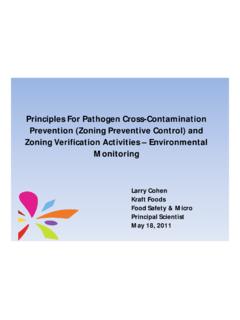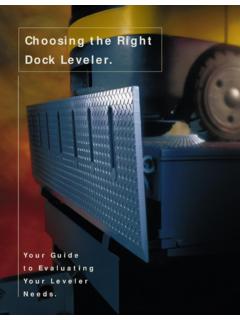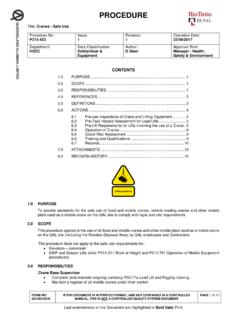Transcription of RECOMMENDED INTERNATIONAL CODE OF PRACTICE …
1 CAC/RCP 44-1995 Page 1 of 13 RECOMMENDED INTERNATIONAL code OF PRACTICE FOR PACKAGING AND TRANSPORT OF TROPICAL FRESH FRUIT AND VEGETABLES CAC/RCP 44-1995 - SECTION I - SCOPE This code recommends proper packaging and transport of fresh fruit and vegetables in order to maintain produce quality during transportation and marketing. - SECTION II - DESIGN, CONDITION AND LOADING METHOD OF TRANSPORT EQUIPMENT Mode of transportation and type of equipment Factors include: - destination; - value of the produce; - degree of produce perishability; - amount of produce to be transported; - RECOMMENDED storage temperature and relative humidity; - outside temperature conditions at origin and destination points; - time in transit to reach destination by air, land, or ocean transport; - freight rates negotiated with the carriers; - quality of transportation service.
2 Reliability and quality of transportation service provided by different carriers must be carefully considered along with the rates charged. Services and schedules are established or modified weekly. Sometimes service is abruptly withdrawn. Shippers should contact air and ocean port authorities at their origin and destination locations to receive the most current information on available services. Local trade publications also are excellent sources of information, as many carriers and their agents advertise their schedules and destinations. When available refrigerated trailers and van containers are RECOMMENDED for most high volume produce with transit and storage lives of a week or more.
3 After transit, there must be enough remaining CAC/RCP 44-1995 Page 2 of 13 produce life for marketing. Carriers utilizing trailers and containers can offer a door-to-door service. This reduces handling, exposure, damage, and theft of the produce. Air cargo containers also can be used to provide a door-to-door service. Produce transported by air is generally high-value and highly perishable. Freight costs are higher by air. Transit times, however, are in terms of hours instead of days. Many produce is shipped in unrefrigerated air containers or on air cargo pallets. This requires close coordination at the origin and destination airports to protect the produce when flights are delayed.
4 Temperature-controlled storage facilities at airports are needed to ensure produce quality. Refrigerated air containers are available and should be used when possible. Use of insulated thermal blankets is an option. Produce which can be shipped in refrigerated trailers and van containers are sometimes shipped by air to take advantage of brief market opportunities, such as the beginning of a season when prices are high and supply is limited. A robust and accurate system for monitoring or displaying temperature and relative humidity during transport in integral containers needs to be considered. Long distance transportation through tropical and frigid climates requires rugged well-designed equipment to withstand the transit environment and protect the produce.
5 Desirable features in refrigerated trailers up to m (48 ft) long and van containers up to 12 m (40 ft) long include for example: - 42,000 kJ/h (40,000 BTU/h) refrigeration capacity at 38oC (100oF) ambient, 2oC (36oF) return air temperature. - a continuously operating high capacity evaporator blower for more even produce temperatures and higher relative humidities; - a solid return air bulkhead at the front of the trailer to ensure air circulation throughout the load; - vertical ribs on the rear door to assist in air circulation; - adequate insulation and provisions for heating, when used in regions where weather conditions so demand due to the nature of the produce; - deep floor grooves or channels, from 50 to 75 mm (2 to 3 mm) in depth to provide an adequate cross-sectional area for air circulation under loads placed directly on the floor.
6 - supply-air temperature sensing of the operation of the refrigeration unit to reduce produce chilling and freezing injury; - provisions for ventilation to prevent ethylene or carbon dioxide buildup; - air-ride suspension to reduce the amount of shock and vibration transferred to the shipping containers and the produce inside. - modern containers in which cold air leaves the front part of the container, but the air flow circulates from below (close to the floor) toward the back, then rising to the upper part of the container. Most carriers check their transport equipment before presenting it to the shipper for loading.
7 The condition of the equipment is critical to maintaining the quality of the produce. Therefore, the shipper also should check the equipment to ensure it is in good working order and meets the needs of the produce. Carriers provide guidance on checking and operating the refrigeration systems. CAC/RCP 44-1995 Page 3 of 13 All transportation equipment should be checked for: - cleanliness--the load compartment should be regularly cleaned for example by steam cleaning; - damage to walls, floors, doors, ceilings should be in good condition; - temperature control--refrigerated units should be recently calibrated and supply continuous air circulation for uniform produce temperatures.
8 Shippers should insist on clean equipment. A load of produce can be ruined by: - smell from previous deliveries or incompatible loads; - toxic chemical residues; - insects nesting in the equipment; - decaying remains of agricultural produce; - debris blocking drain openings or air circulation channels along the floor. Shippers should insist on well maintained equipment and check for the following: - damage to walls, ceilings, or floors which can let in the outside heat, cold, moisture, dirt, and insects; - operation and condition of doors, ventilation openings, and seals; - provisions for load locking and bracing. For refrigerated trailers and van containers, the following additional checks are important: - with the doors closed, have someone inside the cargo area check for light--door gaskets must seal.
9 A smoke generator also can be used to detect leaks; - the refrigeration unit should cycle from high to low speed when the desired temperature is reached and then back to high speed; - determine the location of the sensing element which controls the discharge air temperature. If it measures return air temperature, the thermostat may have to be set- higher to avoid chilling injury or freezing injury of the produce; - a solid return air bulkhead should be installed at the front of the trailer; - a heating device should be available for transportation in areas with extreme cold weather; - equipment with a top air delivery system should have a fabric air chute or metal ceiling duct in good condition.
10 Produce requiring refrigeration should be thoroughly precooled, if necessary, prior to loading into transportation equipment. Produce temperatures should be taken with an appropriate thermometer and CAC/RCP 44-1995 Page 4 of 13 recorded on the bill of lading for future reference. The load compartment in the equipment also should be precooled to the RECOMMENDED transport or storage temperature for the produce. It is advisable that the loading area should be enclosed and if available, the loading dock doorway area should be equipped with doorway air seals. Proper loading practices are critical to maintaining temperature and relative humidity, protecting the produce from impact and vibration forces in transit, and preventing insects from entering the load.













